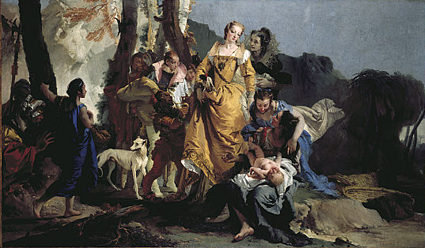Andrew Graham-Dixon sees 'The Glory of Venice' at the Royal Academy as a contest between two great painters, one famous, one unknown
When Giambattista Tiepolo painted The Finding of Moses he turned Egypt into a place that looked sus-piciously like home. The Nile has been shrunk to the proportions of the Grand Canal. Cleopatra has become a courtesan in yellow silks and pearls with a brittle, yapping lapdog, attended by a grinning dwarf and procuress. She looks down at the bawling, red-faced baby Moses, not with the conventional compassion but with a distant frostiness that gives the game away. This is a satire in diguise: Tiepolo's way of insinuating, circa 1740, that innocence does not belong in Venice. Even his paint seems touched with cynicism, uncharacteristically coarse and garish, as if in mimicry of Cleopatra's own cold gaudiness.
''The Glory of Venice: Art of the 18th Century'', at the Royal Academy, commemorates a self-consciously decadent culture on the verge of dissolution. La Serenissima, in the last years of its influence, contemplates its own corruption. Retrospectively, the art of the Venetian 18th century, particularly of the later 18th century, seems moved by a prescient fatalism. Domenico Tiepolo, son of Giambattista, painted scenes of carnival gaiety that now seem strained, like dreams that have begun to turn into nightmares or Watteaus that have begun to turn into Goyas. (His drawings are stranger still, the oddest of them presenting the image of five men, a clown and a dog, their backs turned to us, holding umbrellas, waiting for something inexplicable, while four cursory birds wheel in a wet sky). But it was Francesco Guardi who, disdaining the workmanlike clarity of Canaletto's potboiled souvenirs, created the most enduring images of Venice in decline.
Guardi concentrated on the dilapidation of the city and...


